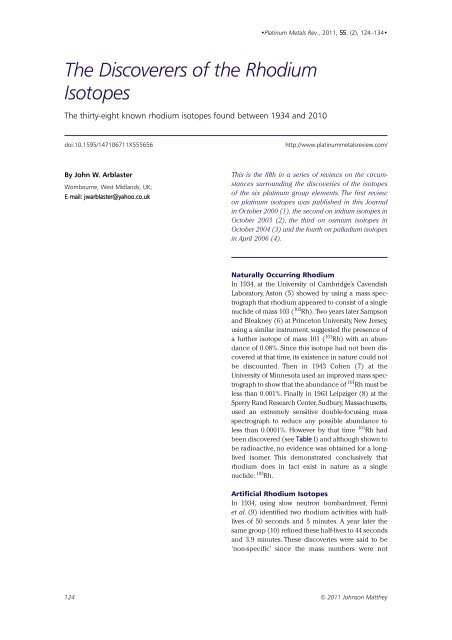Download - Platinum Metals Review
Download - Platinum Metals Review
Download - Platinum Metals Review
You also want an ePaper? Increase the reach of your titles
YUMPU automatically turns print PDFs into web optimized ePapers that Google loves.
•<strong>Platinum</strong> <strong>Metals</strong> Rev., 2011, 55, (2), 124–134•<br />
The Discoverers of the Rhodium<br />
Isotopes<br />
The thirty-eight known rhodium isotopes found between 1934 and 2010<br />
doi:10.1595/147106711X555656<br />
http://www.platinummetalsreview.com/<br />
By John W. Arblaster<br />
Wombourne, West Midlands, UK;<br />
E-mail: jwarblaster@yahoo.co.uk<br />
This is the fifth in a series of reviews on the circumstances<br />
surrounding the discoveries of the isotopes<br />
of the six platinum group elements. The first review<br />
on platinum isotopes was published in this Journal<br />
in October 2000 (1), the second on iridium isotopes in<br />
October 2003 (2), the third on osmium isotopes in<br />
October 2004 (3) and the fourth on palladium isotopes<br />
in April 2006 (4).<br />
Naturally Occurring Rhodium<br />
In 1934, at the University of Cambridge’s Cavendish<br />
Laboratory, Aston (5) showed by using a mass spectrograph<br />
that rhodium appeared to consist of a single<br />
nuclide of mass 103 ( 103 Rh). Two years later Sampson<br />
and Bleakney (6) at Princeton University, New Jersey,<br />
using a similar instrument, suggested the presence of<br />
a further isotope of mass 101 ( 101 Rh) with an abundance<br />
of 0.08%. Since this isotope had not been discovered<br />
at that time, its existence in nature could not<br />
be discounted. Then in 1943 Cohen (7) at the<br />
University of Minnesota used an improved mass spectrograph<br />
to show that the abundance of 101 Rh must be<br />
less than 0.001%. Finally in 1963 Leipziger (8) at the<br />
Sperry Rand Research Center, Sudbury, Massachusetts,<br />
used an extremely sensitive double-focusing mass<br />
spectrograph to reduce any possible abundance to<br />
less than 0.0001%. However by that time 101 Rh had<br />
been discovered (see Table I) and although shown to<br />
be radioactive, no evidence was obtained for a longlived<br />
isomer. This demonstrated conclusively that<br />
rhodium does in fact exist in nature as a single<br />
nuclide: 103 Rh.<br />
Artificial Rhodium Isotopes<br />
In 1934, using slow neutron bombardment, Fermi<br />
et al. (9) identified two rhodium activities with halflives<br />
of 50 seconds and 5 minutes. A year later the<br />
same group (10) refined these half-lives to 44 seconds<br />
and 3.9 minutes. These discoveries were said to be<br />
‘non-specific’ since the mass numbers were not<br />
124 © 2011 Johnson Matthey
















